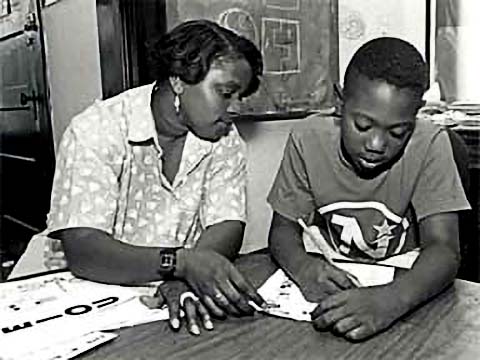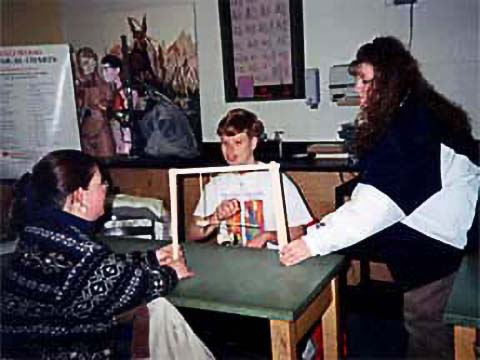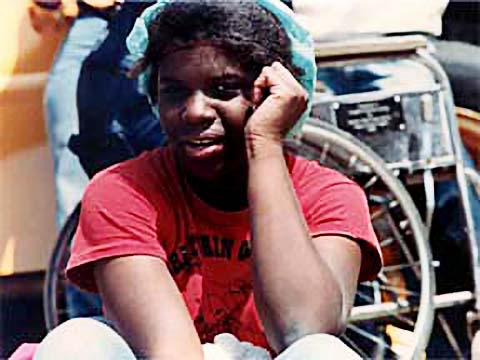Into the New Century: Frustration Mounts. Justice Delayed.
The 21st Century began with an all too familiar set of investigations and complaints about the lack of progress since the original passage of IDEA.
In 2000, National Council on Disability investigators discovered that every state was out of compliance with the requirements of the Individuals with Disabilities Education Act and that U.S. officials were not enforcing compliance.
Even today, schools sometimes place a student in a self-contained classroom as soon as they see that the student is labeled as having a disability. Some students enter self-contained classrooms as soon as they begin kindergarten and never have an opportunity to experience general education. When families of students with disabilities move to a different district, the new school sometimes moves the student out of general education environments and into segregated classrooms.
IDEA 2004
Congress reviewed IDEA 1997 and passed IDEA 2004 with a new set of regulations. It said that progress "has been impeded by low expectations and an insufficient focus on applying replicable research on proven methods of teaching and learning for children with disabilities."
In 2002, The Arc US and AAMR described a pattern of continued segregation and under qualified personnel. They pointed to continuing funding shortfalls and assaults on the goals of IDEA as the cause. Arc US and AAMR described the issues as follows:
The Individuals with Disabilities Education Act (IDEA) requires that students with disabilities be educated to the maximum extent possible with students without disabilities. Despite this law, many students within our constituency remain segregated in self-contained classrooms in separate schools, with limited or no opportunities to interact with non-disabled age peers. Segregation of students in schools perpetuates the alienation of these students. Many do not have access to the same academic and extracurricular activities and services provided to other students. Frequently, these students leave school unprepared for adult life in the community.
Additionally, many schools lack sufficient and/or trained educators and support personnel to provide an appropriate education. Despite some gains, special education programs have never realized the promise of full funding, particularly by the federal government. Some communities still oppose special education and seek to limit educational opportunities for students in special education. Indeed the education of students with disabilities has been under assault on numerous fronts by the press, families, self-advocates and the public

Photo courtesy William Bronston, M.D
MInority Sutdents Face Greater Issues
Issues of segregation and limited education opportunities face all students with disabilities in the 21st Century. Minority students face even greater issues. Minority students, especially African American male children, continue to be significantly overrepresented in those children labeled "developmentally disabled" and "emotionally disturbed." They are also far more likely to be educated in segregated special education settings. "To the extent that minority students are misclassified, segregated, or inadequately served, special education can contribute to a denial of equality of opportunity, with devastating results in communities throughout the nation."
Bridges4kids in Michigan offered the following reasons why many states and local districts are still out of compliance with the Least Restrictive Environment requirement under IDEA:
Our local school systems have failed to demonstrate (or to even attempt to ensure) that every attempt is made to provide the services specified in the IEP in the school that students would attend if they did not have a disability and with children who do not have disabilities.
They have also failed to demonstrate that removal occurs only when the nature or severity of the disability is such that such education in regular class with the use of supplementary aids and services cannot be achieved satisfactorily.

Photo courtesy Ann Marsden
Difficulties Implenting an IEP
Many parents, including the parents whose children are currently placed in segregated settings, report the following difficulties when trying to implement an IEP in a less restrictive environment:
- Appropriate supplementary aids and related services;
- Appropriate personnel supports and related program modifications for school personnel;
- Access to general education curriculum;
- Appropriate positive behavioral supports for students with challenging behavior;
- Teacher preparation neglects to address collaborative practices, positive behavior supports, methods to differentiate instruction and other research-based best practices;
- Integration of functional skills instruction into the context of a general classroom;
- Decisions regarding placement continue to be made, not by individual need as required by law, but by placement in "programs" on the basis of:
- disability label and cognitive level
- staff availability
- administrative convenience
- Low expectation for students;
- Lack of knowledge of the impact of peers and typical school settings.
Paula Kluth, Richard A. Villa and Jacqueline S. Thousand identify some common misconceptions that stand in the way of an inclusive education:
Many families and teachers have the common misperception that students with disabilities cannot receive an inclusive education because their skills are not "close" enough to those of students without disabilities. Students with disabilities, however, do not need to keep up with students without disabilities to be educated in inclusive classrooms; they do not need to engage in the curriculum in the same way that students without disabilities do; and they do not need to practice the same skills that students without disabilities practice. Learners need not fulfill any prerequisites to participate in inclusive education.

Photo courtesy Mary Ulrich
We often hear teachers and families talking about inclusion as if it were a policy that schools can choose to adopt or reject. Special education is not a program or a place, and inclusive schooling is not a policy that schools can dismiss outright.
Since 1975, federal courts have clarified the intent of the law in favor of the inclusion of students with disabilities in general education. A student with a disability should be educated in the school he or she would attend if not identified as having a disability.
The school must devise an individualized education program that provides the learner with the supports and services that the student needs to receive an education in the least restrictive environment possible (LRE).
The standard for denying a student access to inclusion is high… If schools can successfully educate a student with disabilities in general education settings with peers who do not have disabilities, then the student's school must provide that experience.

Photo courtesy William Bronston, M.D
Across the United States, many school districts still operate programs for discrete groups of students. Separate programs and classrooms exist for students identified with certain labels—emotional disabilities, for example—Across the United States, many school districts still operate programs for discrete groups of students. Separate programs and classrooms exist for students identified with certain labels—emotional disabilities, for example—and for students with perceived levels of need, such as those with significant disabilities. In many cases, students enter these self-contained settings without an opportunity to receive an education in a general classroom with the appropriate aids and services…
School districts that automatically place students in a pre-determined type of school or segregated “program” solely on the basis of their disability or perceived level of functioning rather than on the basis of their education needs clearly violate federal laws.

Photo courtesy Sandy Andrews and Connie Johnson
Special Education Studies
https://mn.gov/mnddc/extra/customer-research.htm
In 2012, a general population survey was conducted of Minnesota heads of household and a parallel survey of households with a son/daughter with a developmental disability to compare changes in attitudes about developmental disabilities over the past 50 years Findings regarding education revealed a significantly more negative outlook from households with a family member with a developmental disability about the near term future of education services.
In followup, a qualitative research study was conducted in 2013, K-12 Education Study for Students with Developmental Disabilities, to help determine the basis for these findings. A Narrative Research approach was used. Over 200 stories were collected from 110 individuals that provided an understanding of the current state of public education from the perspective of students, parents, case managers, teachers, public education administrators, and others.
Seven themes emerged from the stories and anecdotes that described the special education experiences of participants – emotional roller coaster, special education in its own bubble, through the cracks, fear of parental empowerment, education heroes, integration to inclusion, and transformation. Focus group participants were then asked to identify elements that would best describe a best case and worst case scenario as it applies to special education services for students with developmental disabilities and families. These elements created two paths, one leading to a desirable outcome and one leading to an undesirable outcome for special education.
Insights gained from the 2013 study guided the design of the 2014 quantitative study, Special Education Experience Survey, done in collaboration with the Minnesota Department of Education, Special Education Division. The purpose of the 2014 study was to obtain benchmark measures of overall quality perceptions and satisfaction with the special education experience from the perspective of parents, advocates, and the students themselves.
Survey results showed that 74% of families with a son or daughter receiving special education services were satisfied; however, only 43% were very satisfied and 20% were very dissatisfied. Satisfaction measures were usually higher in the elementary grades, and lower in middle school and secondary grades.
The majority of respondents provided detailed comments about the reasons for their satisfaction and dissatisfaction ratings. About 54% of comments were positive and 43% were negative. Respondents then rated 39 experience statements and those were rank ordered and specific action items identified that would have the most impact on the overall quality of a student's educational experience.
Special Education Resources
Video: Patrick Schwarz: The Top Questions Asked About Inclusive Education
The top questions asked in these videos:
- What makes a school inclusive?
- Are there some kids, for example those that have significant disabilities, that can't be included?
- When a student has extreme behavior support needs, you couldn't include him, correct?
- How does inclusive education promote successful learning?
- Isn't inclusive education more expensive?
- The best way to include someone is to put them in classrooms with younger peers who are at their level right?
- What are examples of the best supports for students in an inclusive classroom?
- My child seems to have a lack of interest and engagement in the general education classroom. What can we do?
- Don't kids with disabilities learn better in a quiet place separate from all the noise of a general classroom?
- What are the research benefits of inclusive education?
Books: There are a variety of book resources that are worthwhile for further reading about effective quality special education, instruction and inclusive education:
Peer Support Strategies for Improving All Students’ Social Lives and Learning. Carter, W. W., L. S. Cushing, and C.H. Kennedy. 2009. Baltimore: Paul H. Brookes Publishing Co.
Paraprofessional’s Handbook for Effective Support in Inclusive Classrooms. Causton-Theoharis, J. 2009. Baltimore: Paul H. Brookes Publishing Co.
Effective Inclusive Schools: Designing successful schoolwide programs. Hehir, T., and L. I. Katzman. 2012. San Francisco: John Wiley and Sons.
Don’t We Already Do Inclusion?”: 100 ideas for improving inclusive schools. Kluth, P. 2013. “ Wisconsin: Cambridge Book Review Press.
“You’re Going to Love this Kid!”: Teaching students with autism in the inclusive classroom (2nd ed). Kluth, P. 2010. Baltimore: Paul H. Brookes Publishing Co.
Teaching Everyone: An introduction to inclusive education. Rapp, W.H., and K.A. Arndt. 2012. Baltimore: Paul H. Brookes Publishing Co.
Widening the Circle. Sapon-Shevin, M. 2007. Boston: Beacon Press.
From Disability to Possibility: The power of inclusive classrooms. Schwarz, P. 2006. Portsmouth, NH: Heinemann.
From Possibility to Success: Achieving positive student outcomes in inclusive classrooms. Schwarz, P. 2013. Portsmouth, NH: Heinemann.
The School Leaders Our Children Deserve: Seven keys to equity, social justice, and school reform.Theoharis, G. 2009. New York: Teachers College Press.
Joyful Learning: Active and collaborative learning in the inclusive classroom. Udvari-Solner, A., and P. Kluth. 2007. Thousand Oaks, CA: Corwin Press.
A Guide to Co-Teaching: Practical tips for facilitating student learning, 2nd Edition. Villa, R., J. Thousand, and A. Nevin. 2008. Thousand Oaks, CA: Corwin Press.
Brain Friendly Strategies for the Inclusion Classroom: Insights from a neurologist and classroom teacher. Willis, J. 2007. Alexandria, VA: ASCD.
US Supreme Court Decisions
Fry, Et Vir, As Next Friends of Minor E.F., Petitioners v. Napoleon Community Schools, Et Al, 580 U.S. ____(2017)
On Writ of Certiorari to the United States Court of Appeals for the Sixth Circuit
Endrew F, a Minor, By and Through His Parents and Next Friends, Joseph F. Et Al. v. Douglas County School District
On Writ of Certiorari to the United States Court of Appeals for the Tenth Circuit

